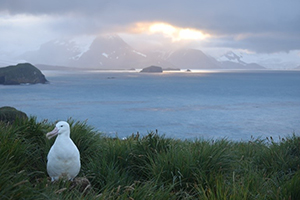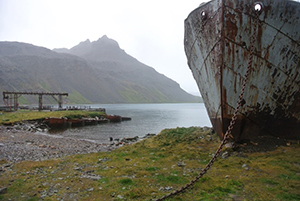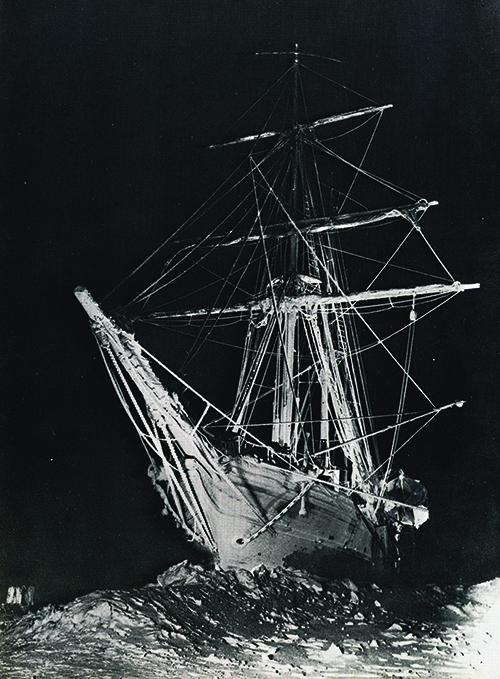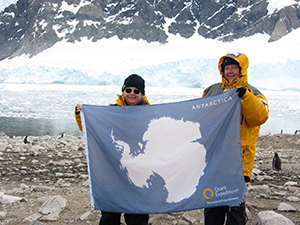Antarctica has been on my bucket list for many years. Earlier this year I ticked that box.
After meeting the group in Buenos Aires we flew to Ushuaia, the main departure point for the Antarctic Peninsula. Our ship Ocean Endeavour took 199 passengers but was dwarfed by the Princess cruise liner moored across the dock, and another expedition ship still bigger than our own.
We set sail through the Beagle Passage, and rumours soon circulated that we had “Shackletons aboard”. Indeed, we did have some distant cousins of the famed Sir Ernest Shackleton, who were soon sharing stories of the great man’s exploits. The journey became infused with the Shackleton influence with several of our landings linked to the story of the miraculous rescue of his crew from the Endurance.
One of our landing groups was named ‘Shackleton’, the others ‘Crean’, ‘Worsley’ and ‘Wild’ in recognition of some of his team.
The weather gods were kind and we had a very smooth crossing. I became quite proficient at spotting Fin Whales, but not being a twitcher, the varieties of albatross were lost on me. We had lectures from on-board experts about how to identify the penguins, whales and other wildlife we hoped to see. We also heard about some of the history of Antarctic exploration and politics.
On arriving at South Georgia we discovered we were the only ship on the island, so had our choice of what to see. We were in zodiacs or ashore two or three times each day. We were lucky enough to visit an albatross rookery on Prion Island. They only nest every second year and a large proportion of the Wandering Albatross in the southern ocean breed on this island. The birds are enormous, each wing spanning almost two metres.

We walked slowly to the top of the island, carefully encouraging the seals to move off the walkway. At the top I was looking down into a gully and saw a large fluff-ball chick. A giant petrel approached. It didn’t look good for the chick. Our guide was quick to point out that we could not interfere, which I knew anyway. Then a second petrel approached. I was getting worried. Until the first petrel started to feed the fluff-ball. Just as well the birds can tell a petrel chick from an albatross chick - I couldn’t.
Salisbury Plain is home to a population estimated at 60,000 breeding pairs, around 250,000 King penguins in all during the moult. That’s not counting the other birds or the seals. It is hard to describe the sheer size of the colony.
We had a few hours at Grytviken, an old whaling station, on Shackleton’s birthday, and raised a dram of good Irish whiskey at his graveside to his memory. He was only 47 when he died, and his wife asked that he be buried at Grytviken. One of the Shackletons with us said a few words and read from the explorer’s journal. Established in 1902 by a Norwegian captain for the Argentine Fishing Company, Grytviken was only finally abandoned in 1965, the rusting machinery eerily evocative of the whale slaughter that took place here October to March for all those decades.

In the whole of the Antarctica region some 1,432,862 whales were taken between 1904 and 1978, when hunting of the larger species ceased.
We then set sail for the Antarctic Peninsula. We arrived and sat off Elephant Island for an hour or so, its being too rough to do a zodiac closer inspection. This is where Shackleton landed his men after they had been in the boats for five days, and 497 days since they had stood on dry land. It is an exposed bare rock. The island is most famous as the desolate refuge of Ernest Shackleton and his crew in 1916.
Following the loss of Endurance in Weddell Sea ice, the 28 exhausted men reached Cape Valentine on Elephant Island after a harrowing ordeal on drifting ice floes. After camping at Cape Valentine for two nights, Shackleton and his crew moved 11 kilometres (7 miles) westwards to a location which offered better protection from rock falls and from the sea, and which they called Point Wild.
They hunted for penguins and seals, neither of which were plentiful in autumn or winter. Many of the crew were already ill and frostbitten, and they were now also in danger of starvation. On August 30, 1916, after four and a half months, one of the men spotted a ship. The ship, with Shackleton on board, was the tug Yelcho, from Punta Arenas, Chile commanded by Luis Pardo, which rescued all the men who had set out on the original expedition. It was the fourth attempt to rescue them.
We stepped ashore on a couple of islands to spend time with glaciers, and more penguins. We finally landed on the mainland at Neko Harbour, thus completing my full set of seven continents.
The ship moored three nautical miles into the harbour because the captain was worried about the ice in the bay and the glaciers. We had a 20 minute run in the zodiacs to land. We came in under the face of the glaciers. The clefts in glaciers and icebergs are a deep azure blue.
I could hear a rumbling sound like an approaching train, followed by a sound like a gunshot, but couldn’t see where the glacier was cracking.
One of the crew pointed out one spot on the face, and soon after, with the next gunshot sound, I saw a small hunk break off into the bay.
The zodiacs headed to sea and everyone moved further away from the beach. The first wave was about 30cm high. As it retreated the water drew back as well. The second wave was about half as big again. Again followed by the water receding. The third wave was almost a metre high. The chunk I saw was only small. I would not have wanted to be there if a larger berg had calved off the glacier. We had been warned to head up the hill, to follow the penguins if they ran up hill.
Antarctica is a fascinating place. All ice, rock, bergs and glaciers. South Georgia was more about the wildlife and the history. The days at sea were a great opportunity to process what we had seen and learned. As a holiday both restful and stimulating, I thoroughly recommend Antarctica.
*********************************************************
Shackleton’s expedition to the Antarctic
by Robin Osborne
In 1914, at the age of forty, the Irishman Ernest Shackleton embarked on what he considered the last great expedition left on earth, the 1800-mile crossing of the Antarctic on foot. The expedition ship Endurance - named after the Shackleton family motto - reached the ice-encrusted waters but just one day short of its destination on the Antarctic coast became stuck in the polar ice of the Weddell Sea.

The pack ice dragged the ship north for ten months before being crushed, forcing the crew to camp on the ice in miserable conditions.
Months later, Shackleton took five of his men and sailed 800 miles in a lifeboat to South Georgia where they crossed a frozen mountain range to reach a whaling station, astounding the rough company of whalers. There have been several attempts to match this feat using modern equipment, and no one has managed to do it any faster.
Immediately, Shackleton - ‘The Boss’ as he was known to his team - launched a rescue effort to retrieve the remaining crew, all of whom were found to have survived.
While he never planted a flag on the South Pole, nor made the fortune he had hoped, Shackleton was feted (and knighted) on his return to England for displaying a leadership style that still makes him a case study in global management.
In the book Shackleton’s Way - Leadership Lessons from the Great Antarctic Explorer the authors write, “His tools were humour, generosity, intelligence, strength, and compassion. That’s Shackleton’s way.”
















